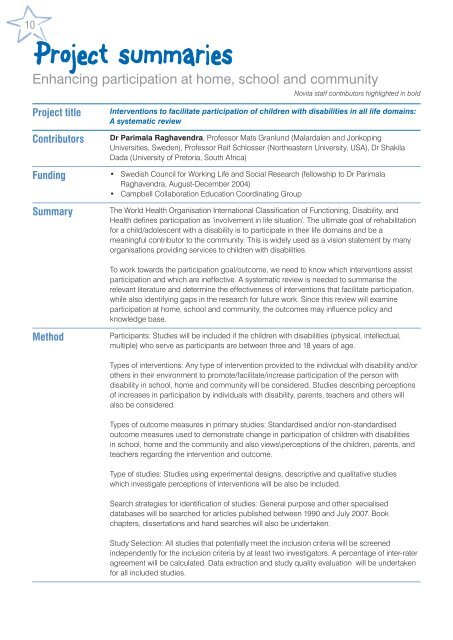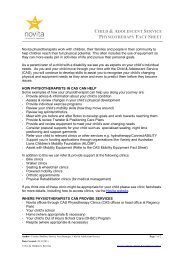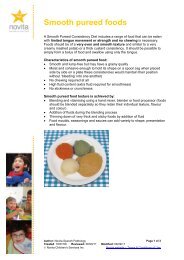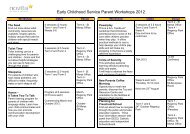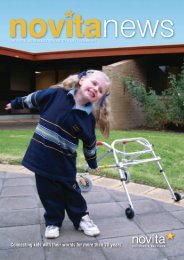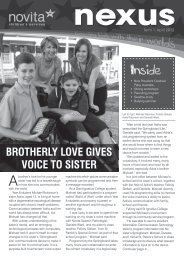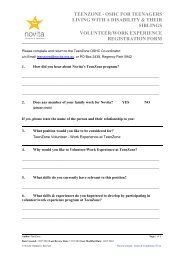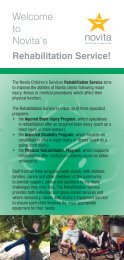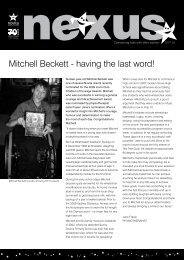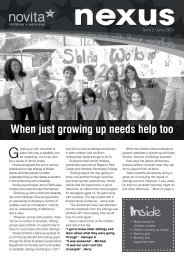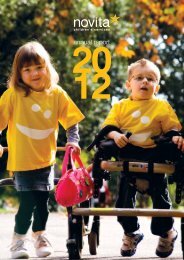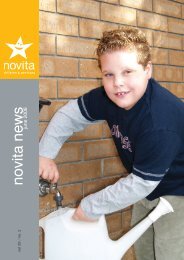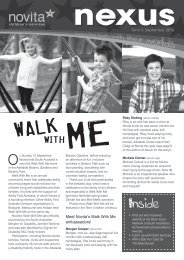Novita Research Report - 2004 to 2007 - Novita Children's Services
Novita Research Report - 2004 to 2007 - Novita Children's Services
Novita Research Report - 2004 to 2007 - Novita Children's Services
- No tags were found...
Create successful ePaper yourself
Turn your PDF publications into a flip-book with our unique Google optimized e-Paper software.
10Project summariesEnhancing participation at home, school and community<strong>Novita</strong> staff contribu<strong>to</strong>rs highlighted in boldProject titleContribu<strong>to</strong>rsFundingSummaryInterventions <strong>to</strong> facilitate participation of children with disabilities in all life domains:A systematic reviewDr Parimala Raghavendra, Professor Mats Granlund (Malardalen and JonkopingUniversities, Sweden), Professor Ralf Schlosser (Northeastern University, USA), Dr ShakilaDada (University of Pre<strong>to</strong>ria, South Africa)• Swedish Council for Working Life and Social <strong>Research</strong> (fellowship <strong>to</strong> Dr ParimalaRaghavendra, August-December <strong>2004</strong>)• Campbell Collaboration Education Coordinating GroupThe World Health Organisation International Classification of Functioning, Disability, andHealth defines participation as ‘involvement in life situation’. The ultimate goal of rehabilitationfor a child/adolescent with a disability is <strong>to</strong> participate in their life domains and be ameaningful contribu<strong>to</strong>r <strong>to</strong> the community. This is widely used as a vision statement by manyorganisations providing services <strong>to</strong> children with disabilities.To work <strong>to</strong>wards the participation goal/outcome, we need <strong>to</strong> know which interventions assistparticipation and which are ineffective. A systematic review is needed <strong>to</strong> summarise therelevant literature and determine the effectiveness of interventions that facilitate participation,while also identifying gaps in the research for future work. Since this review will examineparticipation at home, school and community, the outcomes may influence policy andknowledge base.MethodParticipants: Studies will be included if the children with disabilities (physical, intellectual,multiple) who serve as participants are between three and 18 years of age.Types of interventions: Any type of intervention provided <strong>to</strong> the individual with disability and/orothers in their environment <strong>to</strong> promote/facilitate/increase participation of the person withdisability in school, home and community will be considered. Studies describing perceptionsof increases in participation by individuals with disability, parents, teachers and others willalso be considered.Types of outcome measures in primary studies: Standardised and/or non-standardisedoutcome measures used <strong>to</strong> demonstrate change in participation of children with disabilitiesin school, home and the community and also views\perceptions of the children, parents, andteachers regarding the intervention and outcome.Type of studies: Studies using experimental designs, descriptive and qualitative studieswhich investigate perceptions of interventions will be also be included.Search strategies for identification of studies: General purpose and other specialiseddatabases will be searched for articles published between 1990 and July <strong>2007</strong>. Bookchapters, dissertations and hand searches will also be undertaken.Study Selection: All studies that potentially meet the inclusion criteria will be screenedindependently for the inclusion criteria by at least two investiga<strong>to</strong>rs. A percentage of inter-rateragreement will be calculated. Data extraction and study quality evaluation will be undertakenfor all included studies.


